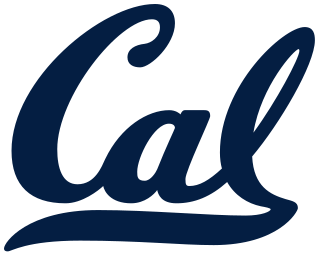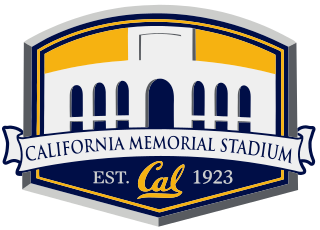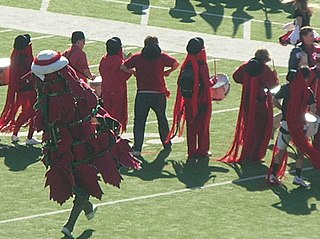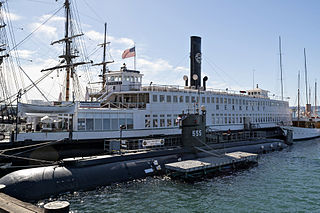
The University of California, Berkeley, is a public land-grant research university in Berkeley, California. It was established in 1868 as the University of California and is the state's first land-grant university and the founding campus of the University of California system. Berkeley has been regarded to be among the top universities in the world for research.

The Daily Californian is an independent, student-run newspaper that serves the University of California, Berkeley, campus and its surrounding community. It formerly published a print edition four days a week on Monday, Tuesday, Thursday, and Friday during the academic year, and twice a week during the summer. Since the beginning of the COVID-19 pandemic in California, however, The Daily Californian has been publishing a print newspaper once a week on Thursdays.

Big Game is the name given to the California–Stanford football rivalry. It is an American college football rivalry game played by the California Golden Bears football team of the University of California, Berkeley, and the Stanford Cardinal football team of Stanford University. Both institutions are located in the San Francisco Bay Area. First played in 1892, it is one of the oldest college rivalries in the United States. The game is typically played in late November or early December, and its location alternates between the two universities every year. In even-numbered years, the game is played at Berkeley, while in odd-numbered years it is played at Stanford.
The Oski Yell is the University of California Berkeley spirit yell from which the school’s mascot, Oski the Bear, derives his name. Although Oski appeared in 1941, the yell was first performed around the turn of the 20th century. The yell's origins are uncertain, although the University of Illinois originated a similar yell in 1899. Another early version is credited to Vince Wirtz, who led a similar cheer beginning in the 1920s at football games for Hamilton, Ontario teams.

California Memorial Stadium also known simply and commonly as Memorial Stadium is an outdoor college football stadium on the west coast of the United States, located on the campus of the University of California in Berkeley, California. It is the home field for the California Golden Bears of the Pac-12 Conference.

The Stanford Tree is the Stanford Band's mascot and the unofficial mascot of Stanford University. Stanford's team name is "Cardinal", referring to the vivid red color, and the university does not have an official mascot. The Tree, in various versions, has been called one of America's most bizarre and controversial college mascots. The tree regularly appears at the top of Internet "worst mascot" lists but has also appeared on at least one list of top mascots.
"The Play" was a last-second, game-winning kickoff return for a touchdown that occurred during a college football game between the Stanford Cardinal and California Golden Bears on Saturday, November 20, 1982. Given the circumstances and rivalry, the wild game that preceded it, the very unusual way in which "The Play" unfolded, and its lingering aftermath on players and fans, it is recognized as one of the most memorable plays in college football history and among the most memorable in American sports.

Berkeley was one of several ferryboats of the Southern Pacific Railroad that for sixty years operated on San Francisco Bay between the Oakland Pier and the San Francisco Ferry Building. Built in 1898 by the Union Iron Works of San Francisco, she served after the 1906 earthquake, ferrying refugees across the bay to Oakland.

The California Golden Bears are the athletic teams that represent the University of California, Berkeley. Referred to in athletic competition as California or Cal, the university fields 30 varsity athletic programs and various club teams in the National Collegiate Athletic Association (NCAA)'s Division I primarily as a member of the Pac-12 Conference, and for a limited number of sports as a member of the Mountain Pacific Sports Federation (MPSF). Over the course of the school's history, California has won team national titles in 13 men's and 3 women's sports and 113 team titles overall. Cal athletes have also competed in the Olympics for a host of different countries. Notable facilities used by the Bears include California Memorial Stadium (football) and Haas Pavilion. Cal finished the 2010–11 athletic season with 1,219.50 points, earning third place in the Director's Cup standings, the Golden Bears' highest finish ever. Cal did not receive any points for its national championships in rugby and men's crew because those sports are not governed by the NCAA. Cal finished 12th in the 2014-15 standings.

Tightwad Hill, is the popular name for Charter Hill, the hill rising to the east of California Memorial Stadium at the University of California, Berkeley in Berkeley, California, U.S..

The California Golden Bears football program represents the University of California, Berkeley in college football as a member of the Pac-12 Conference at the NCAA Division I FBS level. The team plays its home games at California Memorial Stadium and is coached by Justin Wilcox. Since beginning of play in 1886, the team has won five NCAA recognized national titles - 1920, 1921, 1922, 1923, and 1937 and 14 conference championships, the last one in 2006. It has also produced what are considered to be two of the oddest and most memorable plays in college football: Roy "Wrong Way" Riegels' fumble recovery at the 1929 Rose Bowl and The Play kickoff return in the 1982 Big Game.

The 2007 California Golden Bears football team represented the University of California, Berkeley in the 2007 NCAA Division I FBS football season. They played their home games at California Memorial Stadium in Berkeley, California and were coached by Jeff Tedford.
The California Indian Song was a school fight song of the University of California, Berkeley, written by Harold Bingham in 1907 celebrating the rivalry between the California Golden Bears and the Stanford Cardinal. At that time, the mascot of Stanford University was the Stanford Indian, but the mascot was abandoned in 1972 because it was considered offensive. The California Indian Song was also abandoned, but has recently found a new fan base among Golden Bears fans.
"The Stanford Jonah" is a fight song of the University of California, Berkeley written in 1913 by Ted Haley as an entry into a song contest held by the Daily Californian. The song gained popularity when the campus glee club traveled to Europe where the song was a hit and it continues to be a hit at most sporting events, but specifically at events between the California Golden Bears and their rival, the Stanford Cardinal. Georgia Tech's "White And Gold", The Naval Academy's "Up With The Navy", and the University of Montana's "Up With Montana" share this tune as well.
Richard Delano Campbell is a former National Football League (NFL) quarterback who played for the Green Bay Packers (1981–1984) after starring at the University of California in Berkeley. Campbell was a highly touted recruit out of Santa Teresa High School in San Jose, California and was Cal’s starting quarterback for his sophomore through senior seasons, 1978-1980. He earned the highly-valued Joe Roth Award as a sophomore in 1978. Roth, who had helped recruit Campbell to Cal, was a quarterback for the Golden Bears in 1975 and 1976. Roth died of cancer in February 1977 just weeks after completing his 1976 season, and the annual award bearing his name goes to the Cal player who best exemplifies Roth's courage, sportsmanship and attitude.
Dwight Eugene Garner was an American professional football player who was a kick returner for the Washington Redskins of the National Football League (NFL). He played college football as a running back and returner for the California Golden Bears. Garner was involved in The Play for Cal, in which they scored a game-winning touchdown against Stanford after five laterals on a kickoff return. He played in the NFL for Washington in 1986.

The 2008 Stanford Cardinal football team represented Stanford University in the 2008 NCAA Division I FBS football season. The team's head coach was Jim Harbaugh, who entered his second year at Stanford. The team played their home games at Stanford Stadium in Stanford, California and competed in the Pacific-10 Conference. The Cardinal improved on their 4–8 record from the 2007 season by going 5–7. After winning back the Stanford Axe from rival California in 2007 for the first time in five years, Stanford lost the Axe to Cal in the 2008 Big Game.
The 1982 Stanford Cardinal football team represented Stanford University in the Pacific-10 Conference in the 1982 NCAA Division I-A football season. Led by third-year head coach Paul Wiggin, the Cardinal had an overall record of 5–6.

The 2012 California Golden Bears football team represented University of California, Berkeley in the 2012 NCAA Division I FBS college football season. The Bears were led by eleventh-year head coach Jeff Tedford and played their home games at Memorial Stadium after having played at home the previous season at AT&T Park due to reconstruction on Memorial Stadium. They were members of the North Division of the Pac-12 Conference.
The history of California Golden Bears football began in 1886, the team has won five NCAA recognized national titles - 1920, 1921, 1922, 1923, and 1937 and 14 conference championships, the last one in 2006.












